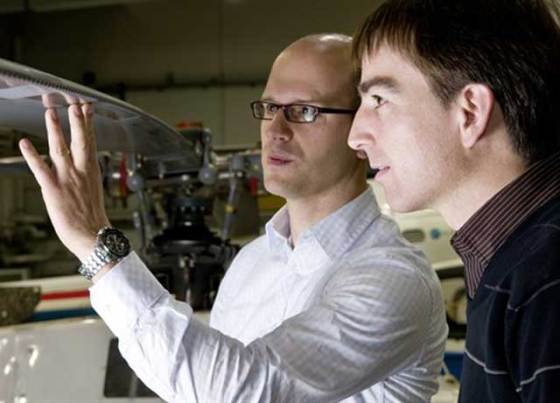Humpback whales inspire new helicopter rotor blade design
 After observing humpback whales, a group of researchers at the German Aerospace Center (Deutsches Zentrum für Luft- und Raumfahrt; DLR) in Göttingen have discovered and flight-tested a way to increase maneuverability and speed of helicopters. The findings could also improve the passenger comfort by lowering the resulting vibration caused by the main rotor.
After observing humpback whales, a group of researchers at the German Aerospace Center (Deutsches Zentrum für Luft- und Raumfahrt; DLR) in Göttingen have discovered and flight-tested a way to increase maneuverability and speed of helicopters. The findings could also improve the passenger comfort by lowering the resulting vibration caused by the main rotor.
Although helicopters are agile and able to take off vertically, their main rotor does contribute to some aerodynamic disadvantages. The airflow over a backward-moving main rotor blade separating from the aerofoil during fast forward flight or maneuvering, referred to as a ‘dynamic stall’, creates turbulence, loss of lift and exerts large forces on the rotor. Drag increases and the rotor head control rods are subjected to large dynamic loads.
“This limits the top speed of helicopters at high altitude and, in particular, their maneuverability”, said Kai Richter from the DLR Institute of Aerodynamics and Flow Technology in Göttingen. “Stalling is one of the most serious problems in helicopter aerodynamics – and one of the most complex.”
Although it may sound surprising, the humpback whales are pretty agile. This is due to their unusually large pectoral fins, which have characteristic bumps along the front edge.
“Research has shown that these bumps cause stalling to occur significantly later underwater and increase buoyancy”, said Holger Mai from the DLR Institute of Aeroelasticity. “Flow phenomena in water are similar to those in air; they just need to be scaled accordingly.”
DLR researchers translated the idea of using bumps for delaying the onset of stalling to helicopter rotors, and patented it as Leading-Edge Vortex Generators (LEVoGs). The artificial bumps on helicopters are smaller than those on a humpback whale; they have a diameter of six millimeters and weigh just 0.04 grams.
Experiments conducted in the wind tunnel were promising, enabling a test flight using the DLR Bo 105 research helicopter in Braunschweig to be successfully carried out, as part of the DLR SIMCOS (Advanced Simulation and Control of Dynamic Stall) project. 186 rubber LEVoGs were glued to each of the helicopter’s four rotor blades.
“The pilots have already noticed a difference in the behavior of the rotor blades”, said Richter. “The next step is a flight using special measuring equipment to accurately record the effects.”
Once perfected, the new blades could be installed on existing helicopters at little expense and the resulting contour could be milled into the front edges of existing titanium blade rotor blade designs.










Leave your response!